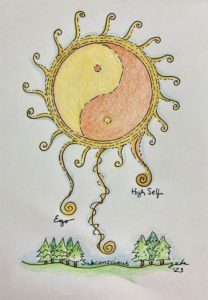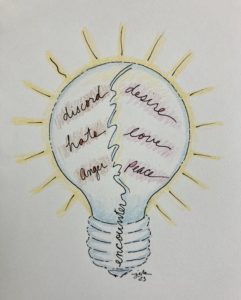
-Illustration © 2023 Jan Ketchel
Karma is destiny, the inevitable effect of a previous cause. That which goes up must come down. And, according to Newton’s Third Law, the force with which it lands will cause a reaction of equal force. This repetitive back-and-forth volleying generates a groundhog day habit of karmic stuckness.
We must circumambulate our habitual beingness until we accrue the consciousness to clearly see our individual core karmic leitmotif. Once filled with awareness of our karmic duty we are then freed to exercise our will to address our oppositions and eventually shift our lives in an equal and reconciled new direction. This is using karma for better.
Esther Harding states:
“The marvel is that there is not a perpetual state of war within the psyche, for each of these elements is endowed with energy and so cannot die. Fortunately for our sanity, many of these irreconcilable elements lie deep within the unconscious, locked in primordial sleep; those which may have stirred are shut away in separate compartments. But as life progresses and an increase of consciousness is achieved, the inner conflicts awaken, and the problem of reconciling the oppositions they reveal has to be undertaken as a serious and urgent task.” –M.E. Harding, Psychic Energy
Cherokee guide Joyce Sequichie Hifler, in A Cherokee Feast of Days, speaks to the karma of a pond turning over. It’s nature’s way of cleaning house. The stagnant energy settled at the bottom of the pond activates, mixes with other strata of water, and rises to the surface. And yes, the whole pond of human affairs needs to turn over at times. This is the cosmic karma of now.
Judge Hatch, a Master teacher in the astral realm, hovered over the battlefields of Earth throughout WW1, channeling his observations and guidance for humanity to his scribe Elsa Barker, in War Letters. His intent was to empower humanity to advance beyond the perennial karma of war. His empowering technology is available to every human being to reconcile with both the warring factions within the self, as well as in the world. Here’s a method to transform hate, the mother of all wars:
“…Has anyone injured you in the struggle of life?—for life is a kind of war. Go out in thought to those whose desires have clashed with your desires, those who have hurt you or hated you. Go to them one by one—not several at a time in this exercise, and one by one try to understand them. See yourself with their eyes, feel toward yourself with their hearts. If they still hate you, you may hate yourself at first in sympathy with them. But remaining there in sympathy with them, you will gradually feel their hard thoughts of you change, gradually begin to be friends with yourself through them.” –Elsa Barker, War Letters From The Living Dead Man.
Judge Hatch emphasizes that this exercise is not a subconscious abuse of black magic to control another because its objective is consonant with the intent of the High Self, one of unselfish union and positive evolution. Carolyn Elliot describes similar exercises of appreciation for the warring factions within the self in her book, Existential Kink.
From the perspective of every individual human as a single cell in the wholeness of everything, every effort—even that of a single person—will impact the state of balance in the overall whole. Furthermore, every individual, however disagreeable, is a permanent member of the whole, for energy cannot die.
What is changeable is the balance between the parts within the whole. We all, as individuals, are subject to the karma of our attitudes, decisions, and actions. The human race, as a whole, is subject to its karma as well. The artistry of being human is our ability to sculpt our beingness with attitudes, decisions, and behaviors that advance our karma for better.
As Judge Hatch describes, the practice of deeply appreciating the perspective of one’s enemy, especially feeling their hatred toward oneself, mitigates the intensity of one’s own anger, harmonizing an opposition within the self and impacting positively one’s outer relationship with the hated other.
Perhaps this technology can be simply summarized in the words of an earlier Master, “love thy enemy.” That’s how to advance the self and use one’s karma for better.
For the better,
Chuck



